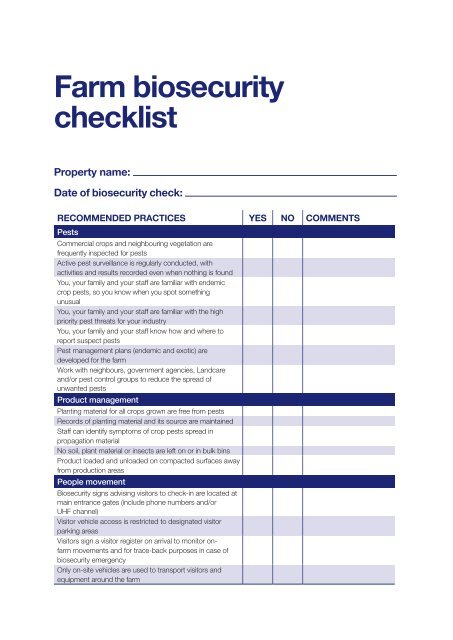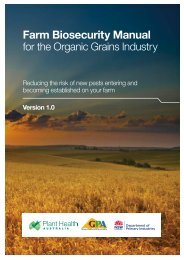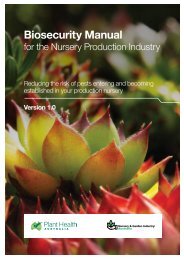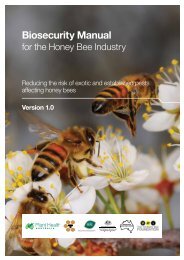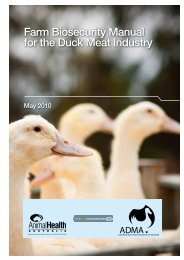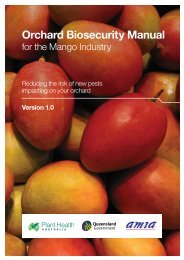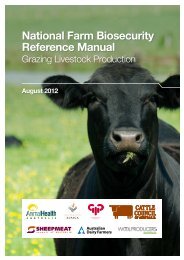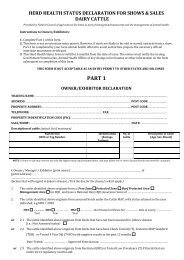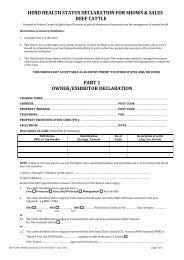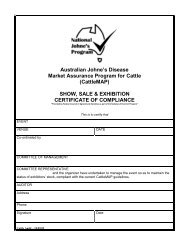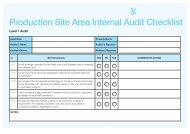Farm biosecurity checklist
Farm biosecurity checklist
Farm biosecurity checklist
You also want an ePaper? Increase the reach of your titles
YUMPU automatically turns print PDFs into web optimized ePapers that Google loves.
<strong>Farm</strong> <strong>biosecurity</strong><br />
<strong>checklist</strong><br />
Property name:<br />
Date of <strong>biosecurity</strong> check:<br />
RECOMMENDED PRACTICES YES NO COMMENTS<br />
Pests<br />
Commercial crops and neighbouring vegetation are<br />
frequently inspected for pests<br />
Active pest surveillance is regularly conducted, with<br />
activities and results recorded even when nothing is found<br />
You, your family and your staff are familiar with endemic<br />
crop pests, so you know when you spot something<br />
unusual<br />
You, your family and your staff are familiar with the high<br />
priority pest threats for your industry<br />
You, your family and your staff know how and where to<br />
report suspect pests<br />
Pest management plans (endemic and exotic) are<br />
developed for the farm<br />
Work with neighbours, government agencies, Landcare<br />
and/or pest control groups to reduce the spread of<br />
unwanted pests<br />
Product management<br />
Planting material for all crops grown are free from pests<br />
Records of planting material and its source are maintained<br />
Staff can identify symptoms of crop pests spread in<br />
propagation material<br />
No soil, plant material or insects are left on or in bulk bins<br />
Product loaded and unloaded on compacted surfaces away<br />
from production areas<br />
People movement<br />
Biosecurity signs advising visitors to check-in are located at<br />
main entrance gates (include phone numbers and/or<br />
UHF channel)<br />
Visitor vehicle access is restricted to designated visitor<br />
parking areas<br />
Visitors sign a visitor register on arrival to monitor onfarm<br />
movements and for trace-back purposes in case of<br />
<strong>biosecurity</strong> emergency<br />
Only on-site vehicles are used to transport visitors and<br />
equipment around the farm
People movement cont.<br />
Contractor entry to the farm is conditional on adhering<br />
to farm <strong>biosecurity</strong> plans and hygiene protocols; site<br />
<strong>biosecurity</strong> inductions are delivered where appropriate<br />
Contractors/visitors made aware if property has a declared<br />
or notifiable pest<br />
Visitors’ clothing, footwear and tools are free of soil or plant<br />
material before entering or leaving the farm<br />
All people recently returned from overseas have clean<br />
footwear and clothes before entering the farm<br />
<strong>Farm</strong> <strong>biosecurity</strong> plan is available for farm staff, consultants,<br />
contractors and visitors<br />
<strong>Farm</strong> staff are trained in <strong>biosecurity</strong> and farm hygiene<br />
practices (e.g. pest management, personal, equipment and<br />
vehicle hygiene practices)<br />
Staff hygiene supplies are available where appropriate<br />
(e.g. hand sanitiser, gloves, masks, disinfectant footbaths,<br />
disposable over-boots and overalls)<br />
Equipment and vehicles<br />
Designated parking area with clear signs provided for<br />
visiting vehicles and contractor equipment and area is<br />
checked frequently for pests<br />
Cleaning and wash-down facilities are provided for people,<br />
machinery and equipment and clearly signposted with<br />
instructions<br />
High-pressure water and air are available for use to remove<br />
plant material and soil from equipment and machinery<br />
Machinery is inspected and disinfected before entering your<br />
production areas<br />
Borrowed and second-hand machinery and equipment are<br />
cleaned of all plant material and soil before use<br />
Sump installed in wash-down facility to catch unwanted<br />
pests and waste, and to stop run-off into waterways<br />
Wash-down facility and surrounds are inspected frequently;<br />
records are kept and updated<br />
<strong>Farm</strong> vehicles are kept clean by regularly clearing the vehicle<br />
floor of soil, weed seeds and insects<br />
Vehicle movement is kept to a minimum in production areas<br />
Vehicle movement is limited to regular pathways through<br />
the farm<br />
Machinery is cleaned before being moved off property<br />
21


